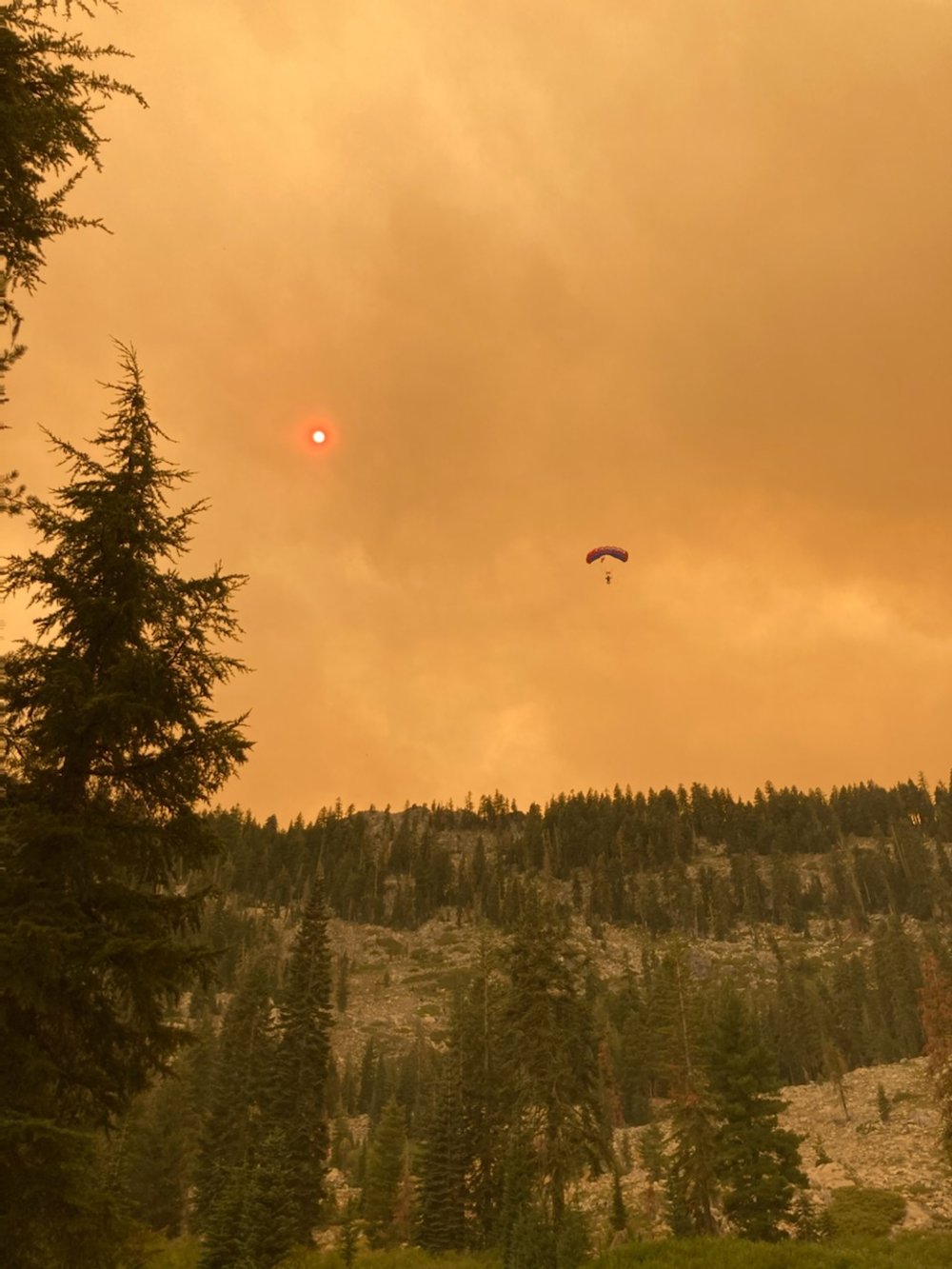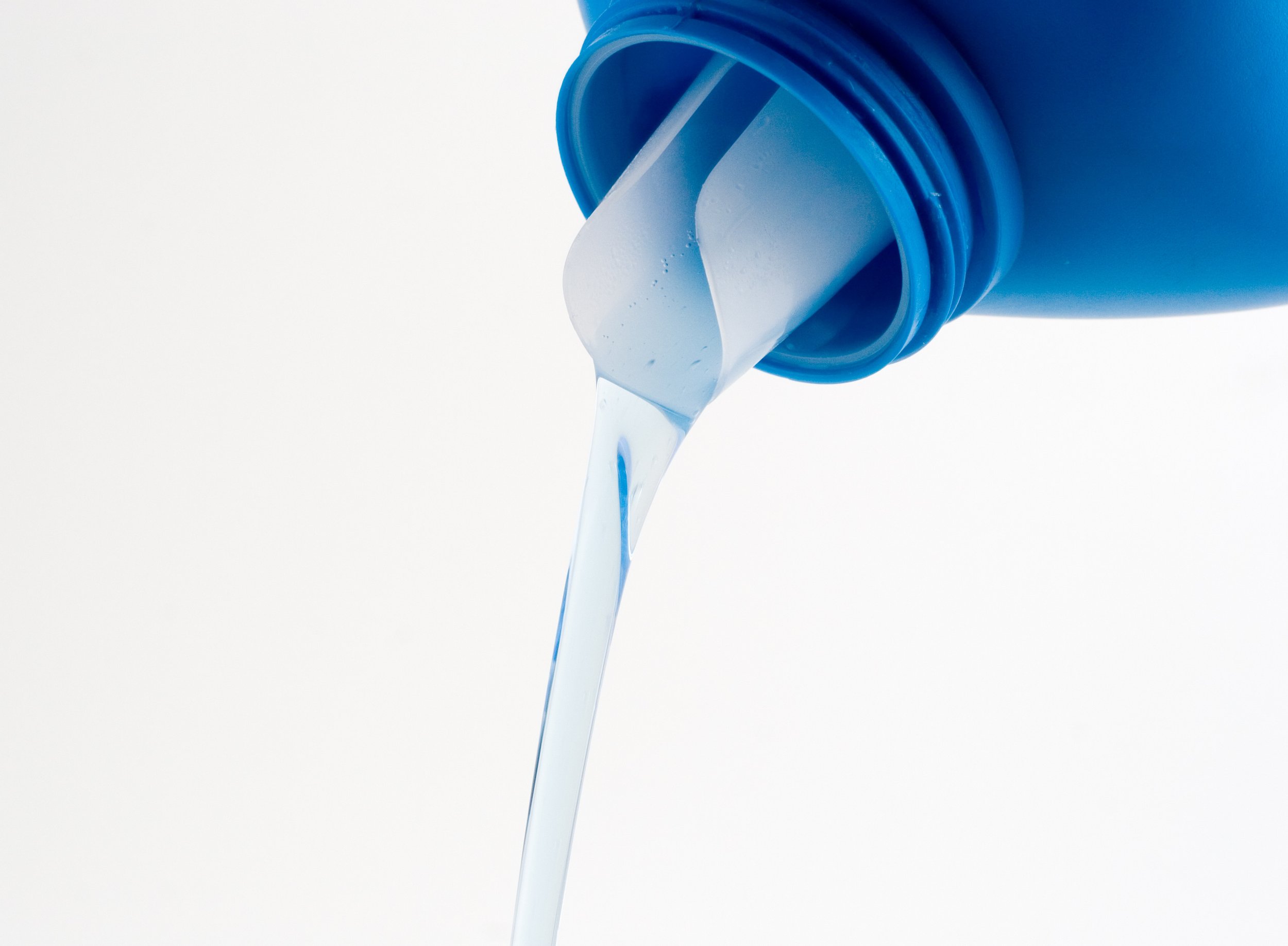The loud hum of propellers spinning radiates as Jason Ramos sits in a Casa 212 on his way to a remote forest fire. Each second brings him one step closer to the job at hand and a day in the life of a smokejumper. As the jump plane arrives in the area of the wildfire, jumpers look out the windows and share information with their JP (jump partner). Winds, smoke, and ground hazards are part of the job as they circle the fire before going into jump operations. Once the spotter has selected a good jump spot with the first jumper in the door JIC (jumper in charge) and briefed, they will go into jump operations. After the spotter gives the command “get ready,” the first jumper gets a quick slap on the leg/shoulder, signifying it's time to go. As Ramos’ turn comes up, he gets in the door and leaps from 1500 ft above the Earth. Approximately five seconds go by before his parachute opens. The first step is complete. Now for the quick ride down to the ground before it’s time to start fighting the fire.
Early in his career, Ramos went through intense training, as all rookie smokejumpers experienced. Completing training in 1999, he responded to various fires throughout his career. As a smokejumper, you can respond to various situations. Think of them as storm chasers. If lightning is present, you can bet a load of smokejumpers is ready to respond. Even with all his experience, Ramos looks to the foundational practice of garment care for his PPE as one of the ways he was able to stay successful in his fire service career. Cleaning PPE garments without damaging them can make the difference between life and death when fighting wildland fires. Ramos was thankfully able to sit down with us and discuss what he believes are the tips and tricks to maintaining PPE safety gear, turnout maintenance, and the importance of picking the correct clothing for firefighters.
“Giving teenagers mentors, leadership, and goals is key to this very important part of their life.”
Ramos started his fire career as a teenager at the age of seventeen with the Riverside County Fire Department. Growing up in LA County/Inland Empire in the late 80s was a huge challenge, with movies like Boulevard Nights and Colors, to name a few, influencing his surroundings. Ramos had to make a clear choice on what path he wanted to go down with his life. After seeing a few classmates become firefighters, Ramos learned that if he wanted fire stations to consider him for the job, he'd have to stay out of trouble. Once he turned seventeen, Ramos went to his local fire department and filled out the application to join. “I didn’t know if I was gonna like the fire department, but I had to do something,” Ramos said. “I wasn’t great at school, so it was a great option at a very young age. It’s heartbreaking that a lot of fire departments are not offering that type of volunteer program in these areas anymore. Giving teenagers mentors, leadership, and goals is key to this very important part of their life. Give them something to strive for - it changed my life, and could do the same for others.”
After entering the fire service, Ramos began to enjoy the work and quickly rose in various responsibilities and qualifications. Years later, he decided to try to become a United States smokejumper. Smokejumpers are aerial delivery firefighters that respond to forest fires via parachute and jumpsuit. Smokejumping requires interesting and very challenging training over a series of weeks that Ramos summed up as “Some days sucked and others really sucked.”
Ramos already started at a challenge being only 5’6’’ in height. “Being on the shorter side of smokejumpers, I had to personally exert more effort due to the heavy loads, exceeding – over 110 pounds on a good day, sometimes much heavier.” Ramos knew before he even was selected for rookie training he had to produce more if he wanted to pass. Many co-workers from his old fire district thought he wouldn’t make it and doubted his abilities simply on his height and weight alone. Veteran smokejumpers didn't take him seriously when talking to him, assuming he would wash out in the first week. Rookie smokejumper training is weeks of PT and learning to manipulate a parachute. Some of these skills pass or fail. There is no special treatment for any rookie candidate. Through blisters and pain, Ramos never gave up. After weeks of dedication and pain management, Ramos passed and became a rookie smokejumper.
“Your body has limits, and if you don’t find those limits, you will never make it in jumping.”
Smokejumping is physically demanding, but the mental toughness you need for it is unmatched. You can work out the body, but it’s much harder to work out the brain. No one is there to pamper you while working, and you need to take extreme ownership of everything you do. Ramos took on the mantra, as all do, “suck it up and just do it,” to push past any challenges he had to overcome. “Your body has limits, and if you don’t find those limits, you will never make it in jumping.” You can't improve if you stay in your comfort zone, and Ramos never gave up on pushing for what he believed was possible.
Everyone has a limit, though, and Personal Protective Equipment (PPE) helps protect things beyond what the human body can control. In Ramos’ first fire at age seventeen, he received second-degree burns on his lower leg and foot. Without firefighter PPE, the rest of his legs would have received the same damage. Fire uniforms, back when Ramos first started wildland firefighting, were night and day compared to what it is now. Ramos even worked with CrewBoss VP of Sales Ryan Davidson to assist with concepts and designs of specific CrewBoss wildland firefighter apparel to improve how PPE could protect first responders.
The early 2000s saw an increase in the effectiveness of firefighter wildland apparel, with fire shirts and pants becoming breathable yet still just as protective as before. Feedback Ramos and other firefighters provided improved how firefighter apparel could protect. “Not everyone is a smokejumper, and not everyone is a hotshot, helitack, engine, etc. If you don’t have these fire people feeding back to the folks making the fire apparel, they don’t know. They’re not firefighters. They're engineers.” Technology has improved with tests for things like cooling and fire resistance. CrewBoss now uses a long list of fabrics and designs to benefit firefighters like Ramos and allow them to continue to fight fires safely. If you want to learn more about these fabrics, you can read all about them here.
With all this new, advanced technology comes proper care for the firefighter outfits. These are high-quality, flame-resistant garments, and you can’t wash them like regular clothing. PPE maintenance is an unsung part of being a firefighter, and Ramos is here to give three tips on better care for everything from Nomex garments to all other PPE.
PPE Maintenance Tips From Jason Ramos
Tip 1
DO NOT put your PPE in the dryer: “The dryer, I use it as my torture machine when we’re testing textiles. When you pull out that lint, all that lint is coming from your textiles and your PPE. I don’t want it in there. I want it on my pants. I don’t want it to break down. I tell firefighters all the time to hang dry them under closure and not in the sun to limit UV degradation. If it’s low relative humidity, they can be dry in just half an hour. If you do have to put it in the dryer, just put them inside out to protect against pilling (small lint balls), but if you can, just do not put your apparel in the dryer.”
Tip 2
Use a good detergent like Defunkify/ or a good firefighter decon detergent when washing: “When you wash them, make sure to use a good detergent and to follow the manufacturer's tag. Don’t use harsh cleaning chemicals. Don’t go to a hardware store and use a fancy degreaser to wash your pants with it. Don’t use bleach.”
Tip 3
Follow the manufacturer’s directions: “It’s pretty cut and dry. Follow the manufacturer’s directions, and you’ll be fine. They’ll last season after season.”
“CrewBoss was always, even from the beginning, top tier, and you guys are even better now.”
PPE protection is necessary for every mission you undertake. Not only is it fire you have to deal with but also wildlife, the elements, and every insect that bites - it can make for an interesting mission. “Every mission, that stuff is protecting us. If you get issued a pair of pants that are too big or too baggy, this can cause a small issue that can lead to an injury or worse.” Fire-resistant clothing needs to protect you from fires, but there is so much more it can do other than be flame resistant. Your life's on the line in more than one way, so it’s critical to take proper care of them and select the right kind of safety garments to fit multiple scenarios. “I tell folks to get good pants because it’s a force multiplier. You’re confident, you feel good, you look good, you’re not tripping as much… If you’re fitted wrong, can you still do a good job? Yes, but you’ll not be as good.”
While Ramos is newly retired from the fire service, he still stays involved by trying to improve firefighter wildland gear through consulting and research. With the importance of safety wear in mind, Ramos still believes CrewBoss is one of the leading manufacturers of fire-resistant clothing.
““I always tell agencies when I consult them to not cheap out. I don’t care what your budget is. Fight for your employees, and don’t buy the cheapest PPE.””
“CrewBoss was always, even from the beginning, top tier, and you guys are even better now. There are some other companies out there whose manufacturing and quality control are just not at that level yet. When you’re buying a cheap pair of pants, there’s probably a reason it’s low-cost. There’s a reason why when you put it on, the pants look like a potato sack… If you got a bunch of threads hanging everywhere and the seams are all uneven, you can tell that the overall quality is not going to be there along with the expected durability. It’s going to be all jacked up. So that’s what I notice about CrewBoss. They’re a well-oiled machine compared to the other manufacturers that are out there.”
In the fire service, there is a way to have an edge. It comes down to research and the ability to put in the effort to go to the next level. Whether it be Wildland, Station Wear, Technical rescue, or Turnouts, you need the best fire service apparel to complete your job. “I always tell agencies when I consult them to not cheap out. I don’t care what your budget is. Fight for your employees, and don’t buy the cheapest PPE. Don’t go and say, ‘Well, we can’t afford CrewBoss this will work.’ It’ll work at the lowest level of protection.”
We need our firefighters to be at their best, and CrewBoss understands this. We will continue to strive and evolve our personal protective equipment to be the shield, barrier, and protection for all who decide to take on the call. The professionals need the best protective garments, and we will push our own limits to ensure that’s exactly what they get.
To learn more about Jason Ramos and his work as a smokejumper, you can read his memoir Smokejumper or visit his website here.











